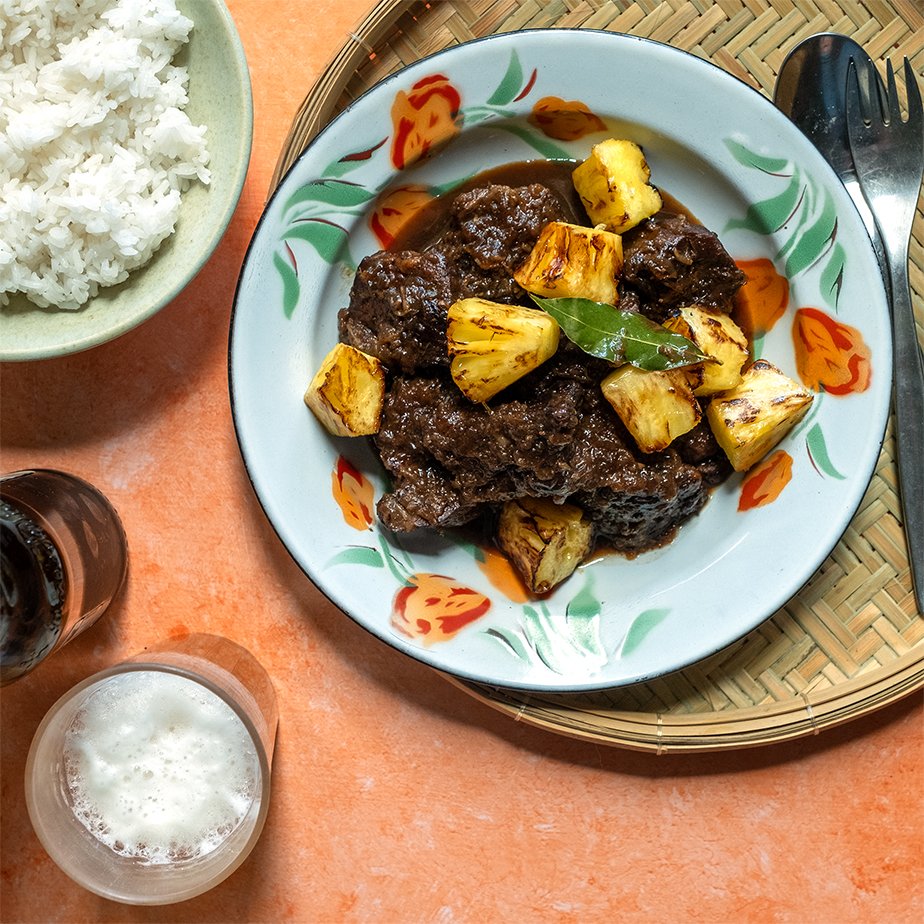Pork and pineapple adobo
We’ve ticked most Asian countries off our travel wish list but have never made it to the Philippines. We know a BIT about the food there but in general we’re kinda sketchy… we understand that Spanish, Chinese, Malay, and American are major culinary influences… that rice is a staple… that pork is big… that there’s a tonne of coast so there must be fish… and there are plenty of different parts and islands, so regionality has to be a feature. That’s about the extent of it and yes, we know. We need to get a bit more schooled. In the meantime, we made adobo, which is virtually the Filipino national dish, to try and plug into those happy Pinoy vibes. Made using either chicken, pork, seafood, vegetables, goat or beef, adobo is heavy on vinegar and the thinking is that this was used to stop meat spoiling in the pre-refrigeration age; vinegar prevents bacterial growth. As that’s not something we care to put to the test, we slung our adobo leftovers into the fridge and we swear they got better by day two and even three. Vinegar also works as a meat tenderiser and our pork was defo tender.
This dish is super-easy to make because unlike many other Asian braises, it doesn’t require an ingredients list the length of the Magna Carta to make it taste good – the main notes are vinegar, soy, bay leaves and black pepper. Pretty straightforward stuff. Filipinos love sour flavours, and have a few of their own vinegars. They’re different to the ones we’re familiar with; firstly there’s palm vinegar, made from the barrel-fermented sap of various palms, including the nipa palm, which grows in estuaries. Palm vinegar can vary in taste and tang depending on which particular tree it comes from. With a slightly salty edge, it keeps fermenting and souring the longer it sits. Cane vinegar is the most common Filipino vinegar and it’s made from sugarcane, which grows abundantly in the country. With a mild flavour, it’s considered all-purpose. Then, there’s coconut vinegar, made by fermenting either coconut water or the sap from coconut palms. We used coconut vinegar in this recipe, which we found to be zippy and quite acidic but also bright and clear-tasting. Use pork belly instead of shoulder, or chicken if you prefer but if you opt for chook, use fattier cuts still on the bone. Such as thighs or drumsticks. Lean breast meat has all the appeal of polystyrene if you long-cook it so don’t even try. We don’t know how traditional the addition of pineapple is; we’ve seen versions using it on the www, and we love the idea. It works well.
SERVES 4
1kg pork shoulder, excess fat trimmed
2 tsp freshly ground black pepper
150ml light soy sauce
2 tsp dark soy sauce
60ml (¼ cup) vegetable oil
1 large onion, very finely chopped
5 garlic cloves, finely grated or chopped
2 tbsp finely grated ginger
160ml (⅔ cup) coconut or palm vinegar (available from Asian food stores)
2½ tbsp firmly packed brown sugar
125ml (½ cup) pineapple juice
3 fresh bay leaves
Steamed rice, to serve
Seared pineapple
1 pineapple, trimmed, peeled and eyes removed
2 tbsp vegetable oil
Cut the pork into large pieces about 4cm across. Combine in a bowl with half the pepper, 2 tbsp of the light soy sauce and all the dark soy, then toss to coat. Cover the bowl and leave for about 30 minutes to marinate.
Heat half the vegetable oil in a large saucepan over medium heat. Add the onion, garlic and ginger, then cook, stirring often, for 7-8 minutes or until softened. Meanwhile, heat the remaining oil in a large frying pan over medium-high heat. Add the pork, then cook, turning often, until well browned all over. Transfer to the saucepan, then add the vinegar, sugar, pineapple juice, bay leaves and the remaining pepper. Pour out any excess oil from the pork pan and discard, then return the pan to the heat. Add about 125ml (½ cup) water, then bring to a simmer, scraping the base of the pan to dislodge any stuck on bits. Pour the liquid into the pan with the pork, adding a little more water if necessary to only just cover the pork. Bring to a simmer, then reduce the heat and cook for 1½ hours, turning the pork if necessary, or until the pork is very tender and the sauce has reduced. Don’t top up the cooking liquid. If you want the sauce sticker, remove the pork using a slotted spoon, then simmer the sauce until it has reduced to your liking, skimming any excess fat from the surface.
For the seared pineapple, cut the pineapple in half lengthwise and remove the core. Cut the pineapple into 2cm pieces. Heat the oil in a large, heavy-based frying pan over medium-high heat, add the pineapple in a single layer, then cook, turning occasionally, for 6-7 minutes or until golden all over. Reheat the pork in the sauce if necessary, taste, then season. Serve with rice, and with the pineapple spooned over.





